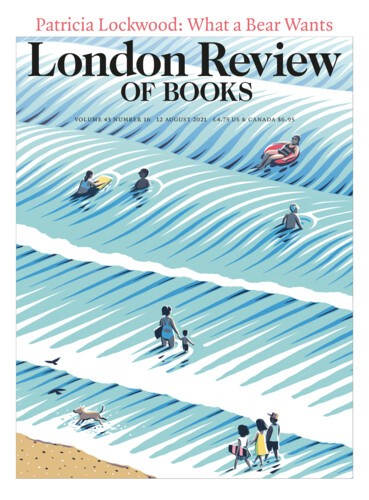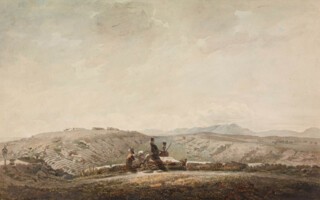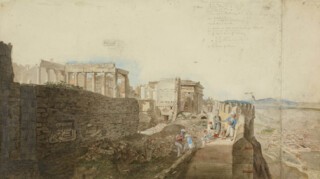Howls of rage greeted the new concrete paths that were laid over the notoriously treacherous rock of the Acropolis last year. Increasing the numbers the site can handle arguably brings visitors closer to the experience of visiting it in the fifth century BCE. At the height of the glory of classical Athens, built on empire and slavery, the sacred area would have been bustling with people. But the new arrangements were deemed a concession too far to mass tourism at the expense of the historical traces of any period, raising the question of how much modernity should intrude into the presentation of the past.
A very different Acropolis is the first thing you see in The Romance of Ruins, the current exhibition at the John Soane Museum (until 5 September). The unfinished watercolour is dominated by the eastern portico of the Parthenon, the ancient temple dedicated to the city’s patron goddess, Athena the Virgin. But the picture also shows a small and elegant mosque inside the skeletal remains, and the building is surrounded by the houses of an Ottoman garrison. In the foreground, women in Turkish dress talk together in one of the courtyards. The only person paying attention to the antiquities is a tiny figure sitting alarmingly high up on the temple’s architrave: a self-portrait by the artist, William Pars, the designated draughtsman on the Ionian Expedition of 1764-66. In reality Pars was paying as much attention to the charm of the courtyard scene as he was to the antiquities, though not in a way that pleased everyone: as his fellow traveller Richard Chandler wrote in the journals he published a decade after their return to England, ‘several of the Turks murmured, and some threatened, because he overlooked their houses; obliging them to confine or remove the women, to prevent their being seen from that exalted station.’
The expedition was organised and funded by the Society of Dilettanti in London, set up in 1732 as a social club for returned Grand Tourists (the male ones, at least: the society, which co-sponsored the exhibition, still maintains an informal ban on women members). Bold or bored British travellers had long ventured beyond the standard confines of the Grand Tour into Ottoman lands. In 1751 James Stuart and Nicholas Revett had undertaken a journey to Athens to measure and record the standing remains of the ancient city – the first time, they insisted, this had been done properly. In 1762 the Society of Dilettanti published Antiquities of Athens, based on Stuart and Revett’s work, to great acclaim. Then it decided to arrange a mission of its own. It would explore the sites of ancient Ionia, a loose collection of Greek-speaking city states poised between Europe and Asia in what is now western Turkey. Commercial interests had made them in antiquity a hothouse for developments in scholarship and architecture inspired by Babylon, Phoenicia and Egypt.
Arrangements were made swiftly: the mission was approved in March 1764, and its three members – a writer, an architect and an artist – were appointed in April. The writer, and expedition leader, was Chandler, a 26-year-old Oxford classicist who specialised in the study of inscriptions. The architect was Revett, now 43, who smarted throughout at being deputy to a less experienced man. At 22, Pars, the aspiring artist, was the party’s junior member. This little band set out from Gravesend in June, under instructions to head for Smyrna (now Izmir), the major port on the western Anatolian coast and seat of the Levant Trading Company. From Smyrna, they were to ‘make excursions to the several remains of antiquity in that neighbourhood, at such different times, and in such manner, as you shall, from the information collected on the spot, judge most safe and convenient’.
Things didn’t go to plan. Plague and political instability complicated their travels in Anatolia, and after nine months – three of them spent in quarantine in a village near Smyrna – they cut their losses and moved on to Greece. There they spent another year, mostly in Athens, where Pars fashioned a cradle that enabled him to spend all day suspended forty feet above the ground producing close-up drawings of the Parthenon frieze, the most detailed to be done before it was dismembered by Lord Elgin in 1801. Unfortunately, most of Pars’s drawings were destroyed in an English country house fire in 1900.
The main product of Pars’s work, however, was a series of watercolour views of ancient sites, worked up from sketches on his return. They appear together for the first time in the Soane Museum show. An introductory room near the beginning of the one-way tour holds the view of the Acropolis as well as an engraving produced for publication from it. The others are displayed in a more conventional new gallery space at the end. The house itself has been left more or less exactly as the architect and collector John Soane lived in it in the early 19th century, its dark corridors stuffed with ancient paintings, sculptures and a few coffins in the basement. It’s a relief to emerge into the airy exhibition rooms, one dedicated to the trip to Ionia proper, the other to the journey in Greece.
The paintings are gorgeous, the presentation elegant, the messages decidedly mixed. The information boards and captions make a simple case: Pars’s work illustrates the impressions and judgments that Chandler recorded in his journals, and so the primary themes are desolation, decline and fall – standard intellectual preoccupations in the 18th century. This is a fair representation of Chandler’s enthusiasms, though not really of a piece with other things he describes: the hustle and bustle of travelling with a large staff, and the frequent meetings with local visitors and dignitaries, often conducted in the simplified Italian that served as the lingua franca of the Mediterranean. It is also at odds with the painstaking reconstruction drawings that Revett made of ancient buildings in their full, though whitewashed, grandeur, and it is definitely at odds with Pars’s paintings. Of the ancient stadium at Laodicea on the Lycus the caption notes: ‘“All was silence, and solitude” wrote Chandler … and a corresponding sense of desolation is palpable in this drawing.’ Perhaps, but that sense is undermined by the five figures in Turkish dress chatting animatedly in the foreground, two other Turks exploring the ancient building, and a camel train crossing the hill beside it.
By including human figures in his drawings, Pars was following the example set by James ‘Athenian’ Stuart not quite fifteen years earlier. He was also honouring the team’s instructions to give ‘the best idea of the ancient and present state of these places’. The unpredictable contrasts he brings out between ancient and present are what make his work distinctive, along with the foregrounding of people as well as places. The publication of his paintings, which proceeded in fits and starts for more than three decades, helped to inspire the cultural Hellenism and architectural neoclassicism that gripped Europe in the later 18th century, and certainly gripped John Soane. They should not be mistaken for a fully developed example of it.
Many of the people Pars depicts are members of the expedition: the three Englishmen, of course, but also their Turkish, Armenian and Jewish servants, who acted as escorts, guides, interpreters, porters and cooks. In one character study a giant capital fallen from a column of the Temple of Apollo at Didyma fills the bottom two-thirds of the canvas, depicted in unusual detail – no doubt with the help of Revett’s architectural drawings – and in realistic shades of beige. The piece of stone has been repurposed as a resting place by Mustapha – an Ottoman soldier and the team’s janizary, working as a bodyguard and local fixer – and a second character, probably the Armenian interpreter. Their bright dress, thoughtful faces and Mustapha’s long-stemmed pipe create an island of colour and interest in the upper part of the painting, while the way they have commandeered the ancient remains captures the reality of modern Ottoman control of the land and its history. According to the caption that accompanies the picture, ‘the images from Didyma are typical of Western depictions of Turks in this period. Unlike the travellers who busily measure, scale and record the remains of antiquity, the Turks appear idle, reclining on ancient monuments seemingly unaware of their significance.’ That may be so – Chandler describes meetings with locals who think the ruins are an old castle – but it’s hard to divine Mustapha and the interpreter’s impressions of the surroundings from the painting alone, and they look watchful rather than relaxed.
In another view of Didyma, Mustapha, wearing the same blue tunic, white trousers and bright red sash, prostrates himself in prayer on a cloak in the foreground, facing away from the ruins of the temple, where a smaller and less colourful Revett sits taking measurements in a jumble of fallen stones. This image of two men engaging with different gods in different ways beside a herd of uninterested goats could be read as an indictment of Islamic superstition in comparison with European science, but even Chandler writes respectfully of the religious observances of the expedition staff, and the painting draws attention to a living religion in a land where the Greek gods have died. The Orient may be Other to Pars, but the hierarchy isn’t yet comfortably settled.
Pars’s contrasts are often humorous, and easily turned against his colleagues. The ruins of the East Gymnasium at Ephesus are the setting for a vignette of the Englishmen relaxing in their tent, smoking and sketching, while around them their servants busy themselves with the necessities of the expedition: cooking, patrolling and standing guard. Another painting shows Revett clambering around the upper parts of the ancient gate of Mylasa, his plain clothing blending into the stonework, while a smart Turkish soldier in a bright blue jacket guards a more ornate modern arch below. The viewer here adopts the perspective of the local aga: Chandler reports his description of a member of the expedition, who must be Revett, climbing on the arch, which was opposite his house, as ‘a brave fellow, but without brains’. Pars pokes fun at himself as well. The only painting to show the Englishmen at large scale depicts them crossing the Maeander River: while Chandler and Revett deal with embarkation as calmly as their local companions, Pars’s horse rears up in alarm at the sight of the ferry raft.
A final pair of paintings of the Acropolis reinforce the curious distinction between the exhibition’s medium and the message it insists on. They’re accompanied by a quotation from Chandler: ‘It is not easy to conceive a more striking object than the Parthenon, though now a mere ruin.’ But the Parthenon is sidelined in one of the views and absent in the other. Instead, centre stage and in full colour, a group of locals are smoking, playing music and in one case recarving an ancient stone, while modern Athens is picked out in detail below. Neither caption mentions these people: the exhibition finds more romance in the ruins.
Send Letters To:
The Editor
London Review of Books,
28 Little Russell Street
London, WC1A 2HN
letters@lrb.co.uk
Please include name, address, and a telephone number.



